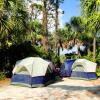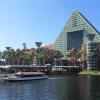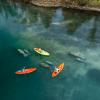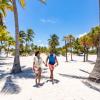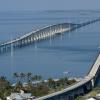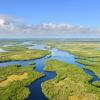Most Frequently Asked Questions about Florida Beaches
Wondering which beaches are the best for you? What the water temperatures will be like when you visit? Looking for the best places to snorkel in Florida? VISIT FLORIDA answers your most frequently asked Florida beach questions here.
By Lauren Tjaden
How do I choose the right beach for me?
Here’s a quick primer on Florida beaches to help you choose. Start by choosing your general location and the time of year you want to visit.
Our page, The Beaches of Florida, can also be helpful.
Gulf of America beaches will tend to have white sand and calm waters that are great for young children or for those timid about the water.
Atlantic beaches tend to have golden brown sand and waves for surfing and other fun.
The Florida Keys offer superb scuba diving, snorkeling and fishing, but are not renowned for their beaches, with the exception of beautiful Bahia Honda. Many of the Florida Keys’ beaches are man-made, or are just a layer of sand over a sliver of limestone.
The north is almost always cooler than south, something to remember in both summer and winter.
Next, you should figure out the general vibe you’re looking for. Do you want a big city like Miami Beach?
Do you want a charming little town with shopping and cafes? A beach where you see almost nobody else, like on Cape San Blas?
Someplace upscale? Someplace old-fashioned? Do you like miniature golf and T-shirt shops, or do you hate them? Florida features beaches on both coasts in all these varieties.
To further research any destination that you find interesting, find its name on the VISIT FLORIDA cities page, and it will give you lots more information, as well as articles and videos, to help you decide which one is the best fit for you.
Which are the closest, best beaches near Orlando, Disney and other Central Florida attractions?
If you're traveling to Walt Disney World or Orlando, you’re only about an hour from a sandy paradise of beaches. These beaches close to Orlando possess distinctly different personalities, so whatever your mood, you’re sure to find one that’s a perfect fit for you.
Beaches are listed from north to south; the estimated driving times and distances are according to Mapquest.
Daytona Beach
The spirited city of Daytona Beach is famed for cars, racing, arts, culture and heritage.
Tradition demands you roll down your car windows and cruise the hard-packed sands of its beach. But you can do it all in Daytona: enjoy watersports, motorcycle racing, kart racing, deep sea fishing and golfing, plus world class dining and shopping. Make sure to investigate its legendary Pier, and don’t forget to zoom over to Daytona International Speedway. If you want to spend a night or two at the beach, this destination is ideal since it offers an abundance of accommodations right on the Atlantic. (58 minutes / 53.81 miles from Orlando)
Ponce Inlet
Ponce Inlet features a wide beach, thick with sand you can drive on, watersports that include parasailing, jet skiing, fishing and renting a speedboat, and even a handsome lighthouse—Florida’s tallest— that challenges you to climb it.
If you have an aversion to high rises and crowds, but love adventure, nature and awe-inspiring beauty, this getaway has your flip-flops written all over it. (1 hour 8 minutes / 61.60 miles from Orlando)
New Smyrna Beach
New Smyrna Beach is the very definition of a perfect day trip. This charming enclave is renowned for its surfing, but that’s just the tip of the sandbar.
You can cruise its hard-packed sand in your car until you find the perfect spot for your beach towel. Enjoy an array of watersports or fabulous fishing, or just kick-back by the waves. Same some energy to discover its quirky shops and vibrant arts community. And don’t miss digging into a generous burger or fresh seafood at Breakers, an open-air restaurant located smack-dab on the beach. (1 hour 3 minutes / 55.66 miles from Orlando)
Canaveral National Seashore, Apollo Beach, northern entrance
Picture impressive dunes giving way to vast sweeps of empty sand, the music of the surf and wind and nothing more, and you’ll have Canaveral National Seashore about right. This utterly tranquil escape boasts the longest expanse of pristine shore in Florida. Fish, swim, go hiking, or just unwind on the beach. Make sure to bring snacks, bottled water, sunscreen and insect repellent since you won’t find them in the Park. (1 hour 15 minutes / 64.55 miles to north entrance from Orlando)
Cocoa Beach
For the quintessential Florida beach experience, escape to popular Cocoa Beach. Make sure to explore its 800 foot Pier, a historical landmark boasting five restaurants, four bars, gift shops, fishing, and free live musical entertainment. Indulge in parasailing, windsurfing, kiteboarding, or learn to surf on its gentle waves. Save time to discover the Ron Jon Surf Shop. It’s the world's largest surf shop, encompassing 52,000 square feet chock-full of beach gear. (1 hour 9 minutes / 59.57 miles from Orlando)
Satellite Beach, Melbourne Beach and Indialantic
The small towns of Satellite Beach, Melbourne Beach and Indialantic feel like old-time Florida, void of crowds, T-shirt shops and pretension. Nestled between the Banana River, the Indian River Lagoon and the Atlantic, these Space Coast destinations are brimming with nature, water sports and outdoor recreation of all kinds, never mind generous, mostly-empty beaches rich with cinnamon-hued sand. A turtle-walk with the Sea Turtle Preservation Society is a not-to-be-missed treat. (1 hour 13 minutes / 67.35 miles; 1 hour 21 minutes / 74.11 miles; and 1 hour 25 minutes / 75.96 miles from Orlando, respectively)
Clearwater Beach
If you prefer a Gulf coast beach, Clearwater Beach is the closest, less than two hours from Orlando. You’ll find the Pier 60 public beach access at the west end of Highway 60, just over the bridge from downtown Clearwater. If you park near Pier 60, everything you'll need is within walking distance.
Which beaches have the clearest water in Florida?
One of the biggest reasons for murky water is suspended or stirred-up sediments, which are caused by water action due to storm swells or waves, or from sediments carried into the ocean from rivers.
Even on Florida beaches where the water tends to be very clear, it varies from week to week, and even from day to day depending on the amount of sunlight, the temperature, the amount of rainfall, the wind speed and direction, water currents and surf.
Florida boasts beaches with crystal clear water, both on the Gulf of America and on the Atlantic Ocean. Water clarity varies from week to week, and even from day to day depending on the amount of sunlight, the temperature, the amount of rainfall, the wind speed and direction, water currents and surf.
The following areas are more likely to have clear water on any given day: northwest Florida beaches in and around Panama City Beach, Destin, Fort Walton Beach, and Pensacola; southwest Florida beaches on Anna Maria Island, Longboat Key and Siesta Key.
Southeast Florida beaches around Fort Lauderdale and Miami; and Florida Keys beaches also tend to have clear water.
This doesn’t mean these are the only beaches that have clear water, just that they are the ones where you are most likely to most often find it.
What about water temperatures? Will it be warm enough to swim?
What’s warm enough for you and what’s warm enough for me may not be the same thing. But generally people will start going in for a swim when the water temperature warms up to around 70 degrees Fahrenheit. At 75 degrees, most people will venture in and at 80, anyone will swim comfortably.
To view a chart of average water temperatures at beaches near where you are going, visit the National Oceanographic Data Center website for Gulf of America and Atlantic Ocean temperatures.
As a general rule, the water anywhere in Florida will be warm enough to swim between April and October. During the cooler months, the farther south you go, the warmer it will be. Fort Lauderdale, Miami, the Keys, Marco Island and Naples will have the warmest water during the winter.
During the summer months, the Gulf of America will be five or more degrees warmer than the Atlantic Ocean. The Gulf may reach 92 degrees or more. In fact, on a July, August or September evening, the Gulf water is warmer than the air. The Atlantic is more likely to top out at 82 to 86 degrees, which makes for a refreshing dip in the summer.
Water temperatures don’t vary as drastically as air temperatures. No matter the conditions, water temperatures usually don’t vary by more than three or four degrees in one day, and the temperatures in nearby locations also usually don’t vary much. For instance, if the Atlantic Ocean is 72 degrees in Cocoa Beach, in Fort Lauderdale it might be 75 degrees.
Which beaches offer the best snorkeling?
A good place to snorkel has the following characteristics: clear water; something interesting to look at like coral, rocks or fish; easy access from the beach; no strong currents or surf; and no boat traffic or fishermen nearby. Here are my best picks.
Snorkeling the Gulf Coast:
- St. Andrews State Park (4607 State Park Lane, Panama City, FL 32408, phone: 850- 233-5140) is home to an extensive shoreline and rock jetties teaming with marine life. Equipment is available for rent at any of its concession stores, or you can bring your own.
- Egmont Key State Park (4905 34th Street South #5000, St. Petersburg FL 33711, GPS coordinates, Ranger Station: N 27 36. 032 W 82 45. 623, Lighthouse: N 27 36. 047 W 82 45. 634, phone: 727- 893-2627), accessible by private boat or public ferry, boasts a submerged fort for you to explore. The shuttle ferry departs from Fort DeSoto Park.
- Point-of-Rocks (Point of Rocks Rd,, Siesta Key, FL 34242) features limestone ledges extending more than 100 yards north and south. Its calm waters make it perfect for beginners.
Snorkeling the Atlantic Coast:
On the Atlantic side, submerged rock ledges run parallel to the beaches along the lower southeast coast. These ledges create excellent snorkeling and diving. Most of the rocks are farther offshore than the average snorkeler can comfortably reach from the beach. However, there are a number of places where the rocks are within a few feet of the beach and in relatively shallow waters. All of the spots close to the beach are much easier to snorkel when there is no surf breaking. Here are a few places to try:
- John D. MacArthur Beach State Park (10900 Jack Nicklaus Drive, North Palm Beach, FL 33408, phone: 561- 624-6952)
- Coral Cove Park (1600 Beach Road, Tequesta, FL 33469, phone: 561- 966-6600)
- Red Reef Park (1400 N. Ocean Blvd., Boca Raton, FL 33483, phone: 561-393-7815)
Snorkeling the Keys:
- Bahia Honda State Park (36850 Overseas Highway, Big Pine Key, FL 33043, phone: 305- 872-2353) offers snorkeling in the shallow water near shore as well as snorkeling tours 9.5 miles out to Looe Key National Marine Sanctuary. It takes about 45 minutes on the boat to get to the reef.
- John Pennekamp Coral Reef State Park (102601 Overseas Hwy, Key Largo, FL 33037, phone: 305- 451-6300) offers a two-and-a-half hour snorkeling tour of the offshore reef.
The best practice is to use a diver's flag and don't snorkel alone. Check with the lifeguards or park personnel for current conditions and local advice before entering the water. Don’t forget to put sunscreen on your back, and remember your waterproof camera.
What are the best beaches in the Florida Keys?
Though the Keys are surrounded by water, they are not renowned for their beaches. Don't expect a typical wide, soft sandy beach like the typical Florida offering. Do expect narrow beaches with shallow—and often very clear—water. These beaches typically boast a lot of live shells, fish and marine animals, so remember your mask and snorkel! There's a lot to see underwater.
Bahia Honda State Park (36850 Overseas Highway, Big Pine Key, FL 33043, phone: 305- 872-2353) is home to the finest beach in the Keys, Sandspur Beach, renowned by Br. Beach as the best beach in the nation in 1991, after which it was no longer eligible for the award.
The Park also is home to the stunningly beautiful Calusa Beach.
The Park doesn’t offer accommodations other than campsites and cabins. So if you aren't roughing it, you'll have to find accommodations on another island that isn't too far away, perhaps in Key West.
One approach you can take to enjoying beaches in the Keys is to stay at a resort with its own private beach. Casa Del Sol Beach Resort near Marathon, Cocoplum Beach & Tennis Club in Marathon and Days Inn Oceanfront Resort on Islamorada are several resorts with their own small private beaches.
Another option is to stay at a resort without its own beach—which is usually less expensive—and drive to a beach for the day or a few hours. A few other good beaches in the Keys are:
- Sombrero Beach (Sombrero Beach Rd., Marathon, FL 33050, phone: 305- 743-0033)
- Smathers Beach (South Roosevelt Blvd., Key West, FL 33040)
- Fort Zachary Taylor Historic State Park Beach (601 Howard England Way, Key West, FL 33040, phone: 305-295-0037)
What about beaches for people with disabilities?
Check out these resources:
- Society for Accessible Travel and Hospitality, or SATH (561-451-0052), provides recommendations for travel agents and other resources to help travelers with disabilities plan their vacations.
- Able Trust (850-224-4493) offers helpful links to disability resources throughout the state from Florida’s Governor’s Alliance for the Employment of Citizens with Disabilities.
- Florida Disabled Outdoors Association provides resources on disabled outdoor travel in Florida.
You probably know regular wheelchairs are hopeless on the beach. However, many Florida beaches offer complimentary use of beach wheelchairs (wheelchairs with the big balloon tires that actually roll through the sand). You can look at the visitors’ services website of whatever destination you choose to find out what they offer. If you call the visitor’s services, they're usually a great help in knowing what exactly is available.
Can you help me find dog-friendly hotels and beaches?
Check out places to stay with your dog here.
Find out more about dog friendly Florida beaches here.


